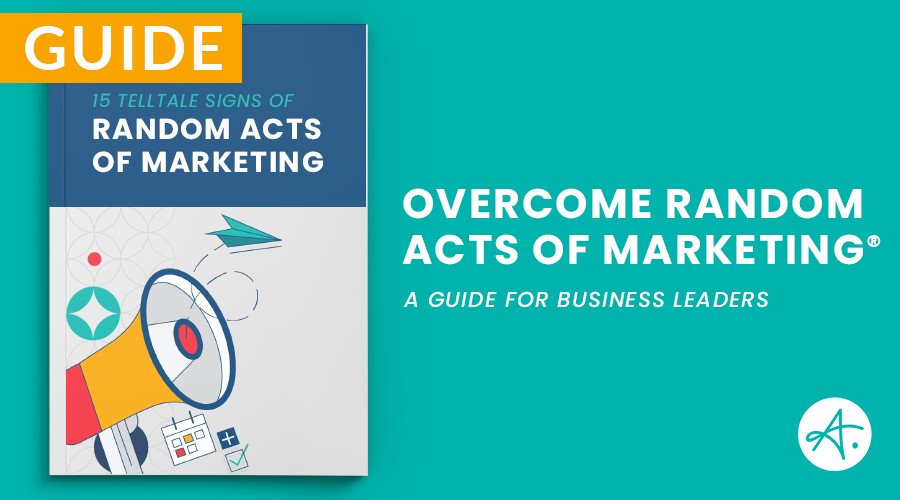Random Acts of Marketing Guide

It’s a story we hear all of the time: A business grew rapidly in its first years by focusing on sales and pursuing whichever opportunities came its way. Eventually, though, growth leveled off. The company needed to do something to jumpstart its sales and fuel its next-level growth. Executives recognized it was time to invest in marketing.
The business didn’t have a marketing leader on staff, so it assigned its founder/CEO or sales leader to the function and maybe even hired a junior marketer or some agency partners. The stand-in marketing leader invested the budget across numerous tactics, channels, and audiences. They thought (and hoped): At least one of these should work, right?
At Authentic, we call this spray-and-pray approach random acts of marketing. It happens when businesses try one marketing tactic after another, frequently gravitating toward the next shiny marketing object. Companies churn out these scattered tactics when they don’t have a strategic marketing plan and leader to ground and guide their efforts. Random acts of marketing are rarely, if ever, an effective approach.
Executives might know they need marketing, but they often don’t know how to structure or measure its effectiveness. Since businesses often see marketing as an overhead expense, they expect to see the impact of their investments quickly. This pressure to deliver a return, coupled with a lack of strategic leadership and time to prove efforts, often leads businesses to commit wasteful and ineffective random acts of marketing.

Random Acts of Marketing [definition]
When growing businesses activate marketing on a reactive, tactical, “shiny object” basis or with short-term, experimental bursts. Ultimately, random acts of marketing burn through resources without building meaningful brand value or delivering consistent revenue returns.

Are you committing random acts of marketing?
We’ve had hundreds of conversations with business executives about their most pressing growth challenges. Through these discussions, we’ve uncovered 15 telltale signs that point to a business committing random acts of marketing.
Recognize your business in any of these signs? It might be time to consider what steps you can take to build a strategic and modern marketing organization to fuel your next-level growth and Overcome Random Acts of Marketing®.
15 Telltale Signs of Random Acts of Marketing
1. You’re not sure what healthy growth means for your organization.
For marketing to be strategic, the team needs to know what healthy growth looks like for your organization. Are you looking for a small, incremental increase over the previous year? Or maybe you aim to double your revenue or get acquired. Healthy growth is different for every organization. Define your growth vision and communicate it to your team.
Businesses that struggle to define healthy growth don’t typically have a clear vision of where they want to be in one, three, or ten years. This lack of clarity leads to reactive, scattered marketing tactics because the team doesn’t know what it’s working toward and how it can best support those objectives. You need a documented strategy that you update quarterly and annually, so departments — including marketing — can build execution plans that support your growth vision.
2. You’re not sure how much you should budget for marketing.
There is no silver bullet for how much a business should invest in its marketing resources and programs. The investment will depend on numerous factors, including whether you run a B2C transactional business or a B2B business with a multiple-year, complex sales cycle.
The most important investment you can make to build a strategic, vibrant brand is in a strategic marketing leader. This leader (whether part-time or full-time) can assess the market and the business’s objectives to provide recommendations on budget, where to direct it, why, and how much of a return to expect.
In many cases, the marketing investments you make today to generate demand might not harvest revenue for a couple of years. You need a marketing leader who knows how to test, iterate, and refine to stay accountable and deliver long-term results.
One of the most common questions we get from clients is, “How much should I spend on marketing?” It seems like a simple question, but unfortunately, the answer isn’t. The not-so-satisfying answer we often give to questions about marketing budget allocation is, “It depends.”
3. Marketing is reporting to a sales leader or founder who is not a marketing leader.
Founders or sales leaders are often responsible for marketing in early-stage growth businesses. This responsibility typically makes sense for your first few years in business. Founders are the closest to your brand story and vision and often communicate it through pitch decks and other business strategy documents and presentations. Sales leaders are focused on net new client acquisition and know the type of information and sales collateral the team needs to close deals.
However, as your business continues to grow, it will likely reach a point when it needs a strategic, revenue-focused marketing partner at the table. Companies that don’t hire an experienced marketing leader get stuck because marketing continues to be an order-taker from sales. This sales-driven approach to marketing leads to scattered tactics that only generate short-term results (at best). Marketing leaders break companies out of this mold to help them shape and align teams and efforts toward future growth.

4. You’ve hired and fired multiple marketers.
The U.S. Department of Labor estimates a bad hire costs 30% of that individual’s first-year expected earnings. This estimate doesn’t count all of the less tangible impacts, including the hit to morale, cost of onboarding a new leader, and decreased productivity. Plus, putting the wrong person in charge of your brand can damage it. Recovering from that can be costly and challenging.
We’ve also worked with numerous companies staffed with junior or mid-level marketers that wonder if they have the wrong people because they aren’t getting results. More often than not, these marketers are capable and committed, but they spend all of their time responding to a firehose of random acts of marketing requests. They can’t develop or demonstrate their strategic value because they spend all of their time just trying to keep up. Before you make the costly decision to fire your marketers, bring in a strategic marketing leader to assess your talent and determine whether you have a people issue or a strategy issue.
5. You’re trying to market everything to everyone because you think any revenue is good revenue.
Not all revenue is ideal revenue. It can be scary to let go of revenue opportunities, but long-term, sustainable growth requires you to make focused strategic investments. If you try to be everything to everyone to capture whatever revenue you can, you’ll likely end up not being anything to anyone. No buyer will choose your brand if you don’t reach them where they’re at or if you don’t know, specifically, what problem of theirs you solve.
Strategic marketing prevents the random spraying of marketing across channels, tactics, and audiences. It enables thoughtful and measured decisions about how best to use your limited resources to target your 1-3 ideal buyers. Your ability to narrow in and focus will help you better connect with these ideal buyers, differentiate you from your competitors, and fuel your growth. Focus requires you to make tough decisions about where — and perhaps more importantly, where not — to point your investments for the greatest impact.

6. There’s no formal feedback loop and collaboration between sales and marketing (or, in a product company, between sales, marketing, and product).
When your business was in its early stages, your teams were likely small, making it easy for everyone to know everything that was happening. You probably didn’t have formal feedback loops in place because they weren’t necessary; communication occurred naturally.
As your company grew, you might have noticed that communication started to break down. This communication breakdown can cause a disconnect between what your sales team experiences in the field, what the product team sees or hears from customers, and what marketing spends their time addressing.
Marketers might create content that doesn’t match customer needs, leaving sales or products frustrated that they’re not getting what they need. Marketing efforts feel disjointed, scattered, and ineffective. At this point in your growth, you need structured, process-driven feedback loops. When sales, product, and marketing teams are communicating and aligned, marketing can better support sales — and vice versa.
7. Marketing is tactical, activity-driven, and approached with a short-term mindset.
Tactic and activity-driven marketing is the clearest sign that your company is committing random acts of marketing. Many times this happens because, in founder-led or sales-driven companies, marketing’s role is to take requests from executives and sales leaders to create whatever they need right now. Your marketers (whether they’re employees, contractors, or agencies) are always scrambling to do whatever the founder or sales leader determines they need.
If this sounds like your business, you likely lack a forward-looking, overarching marketing strategy. Without this, your marketing activities lack direction and alignment with your business objectives. An experienced marketing leader can help you develop a strategy to support growth goals and map out the right short-term sales activation activities and long-term brand-building activities needed to hit those goals. Both types of activities support sales, but your investment in your brand becomes much more valuable over time because it allows you to increase your prices, build brand preference, and scale.
8. Marketing is reactive, driven by shiny objects and flavors of the day.
As your business looked to find its footing in its early days, it likely pivoted regularly and frequently to accommodate market and product changes. This constant change may have led to reactive marketing efforts, typically driven by the shiny marketing object that captured the founder, CEO, or sales leader’s attention that week. But, at some point, your business must commit itself to a specific direction to establish itself in the market. During this growth phase, marketing efforts must be planned and proactive to align with the business’s objectives.
Enabling marketing to support business objectives means giving them a seat at the executive table. When you don’t elevate marketing as an executive peer, they don’t have the authority to push back on requests from leadership and sales that might take the company strategically off course. They’ll always be reactive order-takers that can’t support the business’s growth objectives strategically and effectively. A strategic marketing leader can help you create a strategy aligned with business objectives and test, iterate, and refine the activities to best support your growth.
9. Marketing seems to be in a constant series of 30- or 90-day experiments, and you never know if they’re successful or not.
Most marketing programs — especially in a B2B environment — require one to two years to fully measure success. Making short-burst investments in new tools, campaigns, or agency relationships without letting them run their course doesn’t give you enough time to prove their potential impact. Instead of using marketing to build incremental gains, you suffer losses.
Strategic marketing investment requires a long-term mindset paired with regular measurement and iteration along the way. Experienced marketers know how to navigate pressure for an immediate payoff from investors, board members, and impatient executives. They can help your business stay the course long enough to measure a program’s impact on revenue and sales. Without a strategic leader, companies often make knee-jerk reactions and divest in programs that may have had great potential, but that barely had the opportunity to see the light of day.

10. Your marketing is exactly the same as it was last year, two years ago, or five years ago.
It’s not enough to simply rinse-and-repeat your marketing plan each year with a few small modifications. Marketing trends, techniques, and technologies are evolving at warp speeds. If you don’t evolve alongside them, you miss out on opportunities to engage your audiences in new and innovative ways.
Strategic marketing also requires you to adjust your plan and iterate based on insights you uncover throughout the year. It encourages you to listen to the market and always be ready to innovate, pivot, invest, or divest based on findings. (We help businesses do this through our Authentic Growth® Methodology.) It’s crucial to not only think creatively about your budget and plan each year but to keep that creativity alive throughout the year to evolve it with the market. Never before was the need to create a flexible marketing plan more apparent than it was in 2020 when, almost overnight, businesses scrapped their plans entirely.
11. You’re doing exactly what your competitors are doing.
If you look to your competitors to inform your marketing strategy, you operate on the assumption that 1) their growth plans are the same as yours and 2) they’re doing things the right way. In reality, just because your competitor prioritizes a particular marketing message, campaign, or tactic does not mean it’s what your business should prioritize.
Healthy growth for their business might mean something different than healthy growth for your business. For example, that competitor might be looking to scale rapidly toward an acquisition while you want to build a family business you can live on for generations. Different goals require different strategies.
Focusing too much on competitors can also cause you to miss out on innovative opportunities that support your business’s growth. Plus, when you show up in the same way as your competitors, it does little to differentiate you from them. It’s important to be aware of who your competitors are, but there’s danger in paying so close of attention to them that you start to resemble them.
12. Marketing is only focused on the top of the funnel (driving activities) and not focused on things like customer retention.
It’s a costly mistake to rely on marketing simply to generate new leads. There’s not a single point in the customer’s journey — especially in today’s digital world — when marketing doesn’t play a critical role in driving growth. If your business lacks a strategy for nurturing, retaining, and expanding current customer accounts, it’s missing out on opportunities to increase revenue more readily, through relationships where trust is already established. After all, it costs five to 25 times more to acquire a new customer than to retain an existing one.
Strategic marketing can play a leading role in creating new revenue opportunities across the entire customer lifecycle. Not only does this attention from marketing deepen the revenue value of the customer, but it also improves their experience with your brand. When your customers have positive experiences, they’re more likely to advocate for your business, creating even more revenue opportunities.

13. In general, your agency and freelance partners don’t seem productive, successful, and/or aligned.
Determining how best to resource your marketing team is challenging without a strategic marketing leader. You might not know if you need a digital vs. PR vs. content vs. creative agency or freelancer to support your needs. To make things more complicated, agencies may say they do many things well when, in reality, they excel at one or two core offerings. This lack of clarity puts pressure on non-marketing executives to decide what the agency is good at and whether the services they’re selling to them are actually what they need.
Add in multiple agencies and freelance partners all working on separate projects, and you can quickly have disconnected and unproductive marketing efforts. Experienced marketing leaders know how to navigate and manage these relationships, providing feedback that aligns all partners with the objectives. This leader can help you maximize your external partner investments by deciding where to focus your efforts, which partners should help you execute, where, when, and how.
14. You have no central source of truth for relationship management.
If you’ve avoided implementing a CRM to focus on your core business, product, or service, you’re setting yourself up for big future challenges. While CRM implementation can sometimes feel like an unnecessary distraction, without one, you can easily lose valuable intel acquired by your business over time.
One of the first and most foundational elements to strategic marketing is to have a strong CRM capability to ensure you track, retain, and manage customer information and activities. Your CRM provides valuable business intelligence and insights that can guide your strategy. Without a CRM, all you have is institutional knowledge from the people who have been at the company for a long time (hopefully, they don’t leave!). This institutional knowledge provides you with enough information to form assumptions and hypotheses but doesn’t give you the hard data necessary to measure your marketing efforts and outcomes.
15. You measure engagement metrics or the numbers of leads only.
If you or your agency partners count new lead creation as the ultimate metric for marketing success, it’s time to look for metrics that better represent customer conversion and retention. Too often, businesses invest in generating a high quantity of leads without giving enough weight to the quality of the leads compared to the ideal client profile.
More leads isn’t automatically a good thing if those leads aren’t good leads that your internal resources can nurture effectively with quick follow up and personalized attention. This is especially the case if your employees spend all of their time qualifying or disqualifying large numbers of leads instead of pursuing quality accounts. Similarly, engagement metrics like email open rates or clicks and social media likes or follows mean little without indication that they turn into sales opportunities. Driving activity for the sake of activity and not measuring conversion or retention is a waste of resources that could lead to a bad brand experience.
Marketers – The Value of a Fractional CMO

Our marketers are proven and passionate revenue builders who love what they do and are:
- Seasoned executive advisors who have depth and breadth of experience across industries, business models, markets, and stages of company growth
- Entrepreneurial-minded leaders who share a deep passion for small and mid-size businesses and who love the challenge and opportunity to make a significant impact
- Responsible, accountable, and confident resource managers who treat your business and budgets as their own, and who live out Authentic’s value
Read this blog post to learn about the value of a Fractional CMO.
Mindshare – collective expertise for exponential impact

Authentic Mindshare™ harnesses collective marketing wisdom that brings greater impact through:
- An engaged community of marketing experts who regularly connect to solve problems and share resources in order to move client strategies forward more effectively
- A professional development forum that ensures our CMOs constantly raise the bar in their abilities to bring relevant and modern marketing strategies to the work they do
- A highly curated network of independent and agency experts who provide flexible, scalable, and hyper-focused execution of marketing tactics that support the business vision
Read this blog post to learn more about the collective power of the Authentic Mindshare™.
Methodology – What is Authentic Growth® Methodology?

Our Authentic Growth® Methodology builds business rigor around marketing by implementing:
- A proven process that teaches a simple set of tools, frameworks, and meeting cadences that drive alignment, accountability, and activation
- A habit-forming system that builds high-performing revenue teams and ensures marketing and sales activities remain tied to the business vision
- An agile structure for shaping annual plans and quarterly activities while maintaining flexibility to adapt to ongoing changes and insights
Read this blog to learn more about how to turn an EOS marketing strategy into action.
Authentic: A solution to random acts of marketing
At Authentic, we help great businesses reach next-level growth through alignment, accountability, and focus. A big hurdle we help you overcome on your growth journey is random acts of marketing. Our experienced senior marketers help your team replace scattered, ineffective, spray-and-pray tactics with strategic, thoughtful, integrated, and consistent marketing execution using our Authentic Growth® Methodology.
If you’re a growing company that’s ready to put random acts behind you and make marketing a sustained, strategic, sales-aligned aspect of your business, let’s connect. We’ll share how Authentic’s unique approach, powered by Marketers, Methodology, and Mindshare, can help you build strong muscle in your marketing teams and programs.
